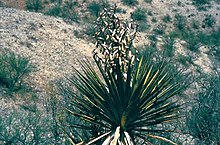| Sahualiqui | |
|---|---|

| |
|
Scientific classification
| |
| Kingdom: | Plantae |
| Clade: | Tracheophytes |
| Clade: | Angiosperms |
| Clade: | Monocots |
| Order: | Asparagales |
| Family: | Asparagaceae |
| Subfamily: | Agavoideae |
| Genus: | Yucca |
| Species: | Y. grandiflora
|
| Binomial name | |
| Yucca grandiflora | |
Yucca grandiflora Gentry [2] is a plant in the family Asparagaceae, native to the Sierra Madre Occidental in the Mexican states of Chihuahua and Sonora. [3] [4] [5]
Common names include Sahualiqui and Large-flowered Yucca. The Pima Bajo peoples of the region sometimes eat the immature fruits. [6]
It has a wide range, although it has a very low population density where it occurs. [1]
References
- ^ a b Ayala-Hernández, M.M.; Solano, E. (2020). "Yucca grandiflora". IUCN Red List of Threatened Species. 2020: e.T117427994A117470067. doi: 10.2305/IUCN.UK.2020-2.RLTS.T117427994A117470067.en. Retrieved 20 November 2021.
- ^ H.S. Gentry, Madrono 14: 51-53. 1957.
- ^ Gentry, H.S. 1972 The Agave family in Sonora. USDA Agricultural Handbook 399.
- ^ Southwestern Biodiversity Yucca grandiflora, map
- ^ Laferrière, Joseph E. 1994. Vegetation and flora of the Mountain Pima village of Nabogame, Chihuahua, Mexico. Phytologia 77:102-140.
- ^ Laferrière, Joseph E., Charles W. Weber and Edwin A. Kohlhepp. 1991. Use and nutritional composition of some traditional Mountain Pima plant foods. Journal of Ethnobiology 11(1):93-114.
| Sahualiqui | |
|---|---|

| |
|
Scientific classification
| |
| Kingdom: | Plantae |
| Clade: | Tracheophytes |
| Clade: | Angiosperms |
| Clade: | Monocots |
| Order: | Asparagales |
| Family: | Asparagaceae |
| Subfamily: | Agavoideae |
| Genus: | Yucca |
| Species: | Y. grandiflora
|
| Binomial name | |
| Yucca grandiflora | |
Yucca grandiflora Gentry [2] is a plant in the family Asparagaceae, native to the Sierra Madre Occidental in the Mexican states of Chihuahua and Sonora. [3] [4] [5]
Common names include Sahualiqui and Large-flowered Yucca. The Pima Bajo peoples of the region sometimes eat the immature fruits. [6]
It has a wide range, although it has a very low population density where it occurs. [1]
References
- ^ a b Ayala-Hernández, M.M.; Solano, E. (2020). "Yucca grandiflora". IUCN Red List of Threatened Species. 2020: e.T117427994A117470067. doi: 10.2305/IUCN.UK.2020-2.RLTS.T117427994A117470067.en. Retrieved 20 November 2021.
- ^ H.S. Gentry, Madrono 14: 51-53. 1957.
- ^ Gentry, H.S. 1972 The Agave family in Sonora. USDA Agricultural Handbook 399.
- ^ Southwestern Biodiversity Yucca grandiflora, map
- ^ Laferrière, Joseph E. 1994. Vegetation and flora of the Mountain Pima village of Nabogame, Chihuahua, Mexico. Phytologia 77:102-140.
- ^ Laferrière, Joseph E., Charles W. Weber and Edwin A. Kohlhepp. 1991. Use and nutritional composition of some traditional Mountain Pima plant foods. Journal of Ethnobiology 11(1):93-114.
